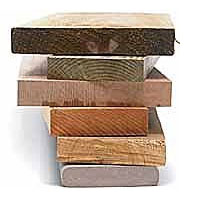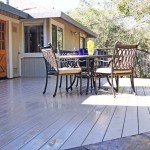As featured on Angie’s List.com…
An exciting part of planning your new deck involves choosing the right decking for your lifestyle. The first step is deciding between natural wood and non-wood decking.
Wood can be beautiful, but keeping it that way requires regular maintenance. Composite decking may require less maintenance, but still sometimes needs to be cleaned and sealed. Synthetic decking is the lowest maintenance choice.
In this article we will focus on non-wood decking options.
Composites, capped composites or synthetics?
Composite decking
The original non-wood decking was made with wood fiber mixed with plastic. While composite decking may require less maintenance than wood, it has a variety of drawbacks.
Composite decking is soft and easily scratched. Moving furniture or even dogs playing on the deck can cause lasting damage. These decks are also prone to fading.
They can absorb moisture, which leads to mildew and mold growth. They also absorb stains from spills such as wine or barbecue splatters. Composite decking has a history of failures including crumbling and decomposition.
Capped composites start with the inexpensive core of wood/fiber composite and add a thin layer of harder plastic (generally PVC). This gives better performance characteristics than composites, including better resistance to scratches, fading and staining.
The drawbacks have to do with the long-term adhesion of the laminated cap and other problems related to the composite core. Capped composites are sometimes warranted against fade for the life of the product.
Synthetic decking
Synthetic decking is the gold standard in ultra low-maintenance decking. The best technology is called cellular PVC. It has a very tough surface that is difficult to scratch.
The colors are very stable, so fading is not a problem. They are impervious to moisture damage and therefore easy to clean. Most spills can be cleaned up with soap and water. Each company has a different warranty, but across the board, the protection is fairly comprehensive.
The best performance we have seen with non-wood decking has been in Azek and TimberTech’s XLM line. Both products have consistently delivered superior customer satisfaction over the large number of decks we have built.
Other considerations
Safety: Unlike many traditional wood decks, non-wood decks are splinter-free and slip-resistant, making your home a little safer for bare feet, small children and pets. PVC actually has better traction when wet than dry.
Durability: In our experience, synthetic decking is the longest lasting material available. We have seen no evidence of deterioration or wear on synthetic decks that have been used for years.
Increased home value: Synthetic decks won’t deteriorate and neither will your investment. A well-built synthetic deck will be as sound and solid at 20 years old as the day it was built.
 Color and accessory selection: Low-maintenance decking manufacturers offer a variety of color choices – many that even emulate the look of traditional lumber or exotic hardwood. In addition, you can find deck accessories ranging from railing, gates and post caps to deck lighting, all designed to complement and enhance the beauty and safety of the deck.
Color and accessory selection: Low-maintenance decking manufacturers offer a variety of color choices – many that even emulate the look of traditional lumber or exotic hardwood. In addition, you can find deck accessories ranging from railing, gates and post caps to deck lighting, all designed to complement and enhance the beauty and safety of the deck.
Long-term cost: Many people are surprised to hear that wood can be more expensive than synthetics in the long run. Though the initial cost of wood may be less, add in the cost of on-going maintenance and a synthetic deck can recoup its additional cost in as little as five years. More important, even well-maintained wood deck boards may need replacement in less than 20 years.
Low-maintenance decking or wood decking – a personal choice
TimberTech and Azek are both top-rated synthetic decking materials with which we have extensive experience. Both are low-maintenance, safe, durable and increase the value of your home.
Both maintain their color and beauty for years without painting, staining or sealing. They resist mildew, warping and insects, so there’s no need to replace rotting, uneven or termite-damaged boards.
A reputable deck builder and installer will help you choose which type of decking meets your needs, both in appearance and budget.
 About this Angie’s List Expert: Weston Leavens is the owner of Deckmaster Fine Decks, providing decks and porches in North Bay, Calif. Since 1983, Deckmaster Fine Decks has specialized in deck design and build, repair and refinish for all kinds of decks. They also offer arbors, patio covers, pool decks and more. You can follow this #ALExperts contributor on Twitter @DeckmasterFD.
About this Angie’s List Expert: Weston Leavens is the owner of Deckmaster Fine Decks, providing decks and porches in North Bay, Calif. Since 1983, Deckmaster Fine Decks has specialized in deck design and build, repair and refinish for all kinds of decks. They also offer arbors, patio covers, pool decks and more. You can follow this #ALExperts contributor on Twitter @DeckmasterFD.


